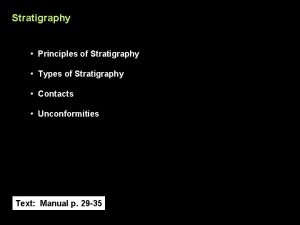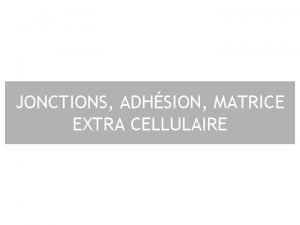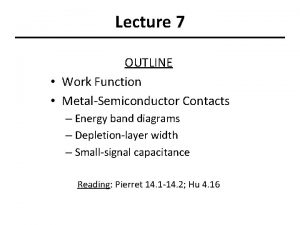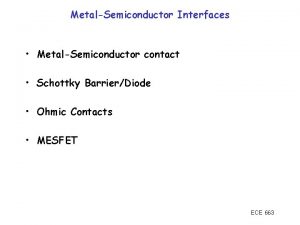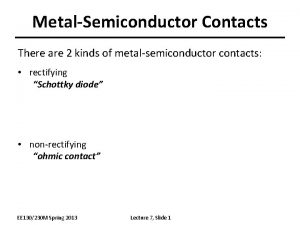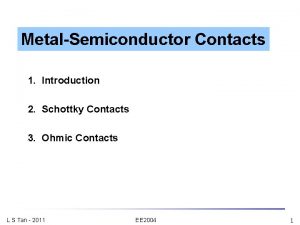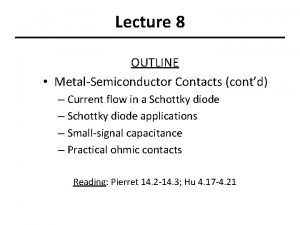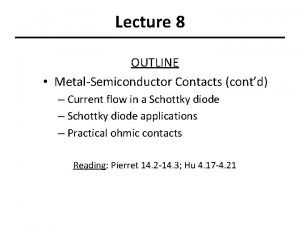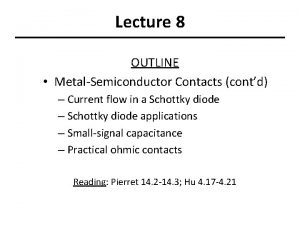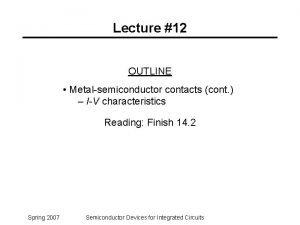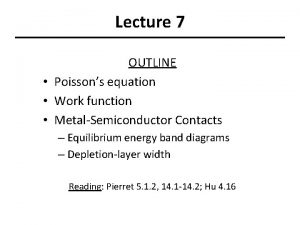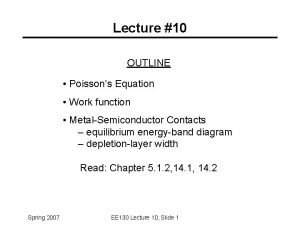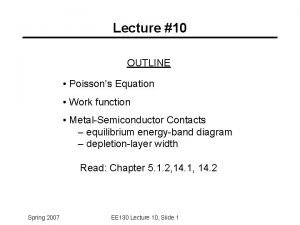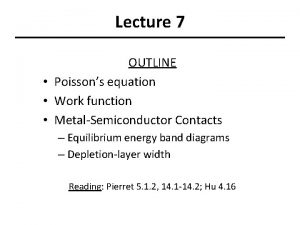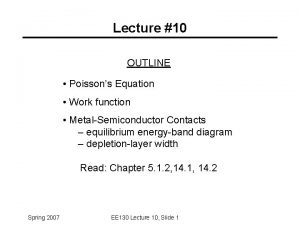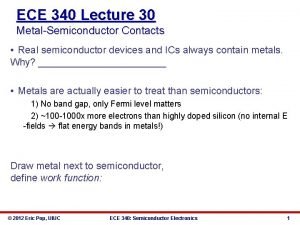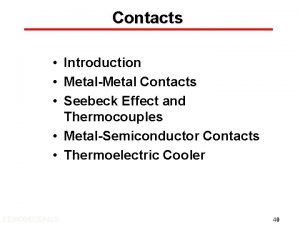Lecture 7 OUTLINE Work Function MetalSemiconductor Contacts Energy





















- Slides: 21

Lecture 7 OUTLINE • Work Function • Metal-Semiconductor Contacts – Energy band diagrams – Depletion-layer width – Small-signal capacitance Reading: Pierret 14. 1 -14. 2; Hu 4. 16

Metal-Semiconductor Contacts There are 2 kinds of metal-semiconductor contacts: • rectifying “Schottky diode” • non-rectifying “ohmic contact” EE 130/230 A Fall 2013 Lecture 7, Slide 2

Work Function E 0: vacuum energy level R. F. Pierret, Semiconductor Fundamentals, Figure 14. 1 FM: metal work function EE 130/230 A Fall 2013 FS: semiconductor work function Lecture 7, Slide 3

Ideal M-S Contact: FM < FS, n-type Band diagram instantly after contact formation: Equilibrium band diagram: EE 130/230 A Fall 2013 Lecture 7, Slide 4 R. F. Pierret, Semiconductor Fundamentals, Fig. 14. 2

Ideal M-S Contact: FM > FS, n-type Band diagram instantly after contact formation: Equilibrium band diagram: Schottky Barrier Height: EE 130/230 A Fall 2013 q. Vbi = FBn– (Ec – EF)FB n Lecture 7, Slide 5 W R. F. Pierret, Semiconductor Fundamentals, Fig. 14. 2

Effect of Interface States on FBn • Ideal M-S contact: FBn = FM – c • Real M-S contacts: A high density of allowed energy states in the band gap at the M-S interface “pins” EF to be within the range 0. 4 e. V to 0. 9 e. V below Ec FM FBn C. C. Hu, Modern Semiconductor Devices for ICs, Figure 4 -35 EE 130/230 A Fall 2013 Lecture 7, Slide 6

Schottky Barrier Heights: Metal on Si • FBn tends to increase with increasing metal work function EE 130/230 A Fall 2013 Lecture 7, Slide 7

Schottky Barrier Heights: Silicide on Si Silicide-Si interfaces are more stable than metal-silicon interfaces and hence are much more prevalent in ICs. After metal is deposited on Si, a thermal annealing step is applied to form a silicide-Si contact. The term metalsilicon contact includes silicide-Si contacts. EE 130/230 A Fall 2013 Lecture 7, Slide 8

The Depletion Approximation The semiconductor is depleted of mobile carriers to a depth W Þ In the depleted region (0 x W ): r = q (ND – NA) Beyond the depleted region (x > W ): r=0 EE 130/230 A Fall 2013 Lecture 7, Slide 9 R. F. Pierret, Semiconductor Fundamentals, Fig. 14. 4

Electrostatics • Poisson’s equation: • The solution is: EE 130/230 A Fall 2013 Lecture 7, Slide 10 R. F. Pierret, Semiconductor Fundamentals, Fig. 14. 4

Depletion Width, W At x = 0, V = -Vbi • W decreases with increasing ND EE 130/230 A Fall 2013 Lecture 7, Slide 11 R. F. Pierret, Semiconductor Fundamentals, Fig. 14. 4

Voltage Drop across the M-S Contact • Under equilibrium conditions (VA = 0), the voltage drop across the semiconductor depletion region is the built-in voltage Vbi. • If VA 0, the voltage drop across the semiconductor depletion region is Vbi - VA. EE 130/230 A Fall 2013 Lecture 7, Slide 12 R. F. Pierret, Semiconductor Fundamentals, Fig. 14. 3

Depletion Width, W, for VA 0 Last time, we found that At x = 0, V = - (Vbi - VA) • W increases with increasing –VA • W decreases with increasing ND EE 130/230 A Fall 2013 Lecture 7, Slide 13 R. F. Pierret, Semiconductor Fundamentals, Fig. 14. 4

Charge Storage in a Schottky Diode • Charge is “stored” on both sides of the M-S contact. – The applied bias VA modulates this charge. R. F. Pierret, Semiconductor Fundamentals, Fig. 14. 4 EE 130/230 A Fall 2013 Lecture 7, Slide 14

Small-Signal Capacitance • If an a. c. voltage va is applied in series with the d. c. bias VA, the charge stored in the Schottky contact will be modulated at the frequency of the a. c. voltage ® displacement current will flow: EE 130/230 A Fall 2013 Lecture 7, Slide 15

Using C-V Data to Determine FB Once Vbi and ND are known, FBn can be determined: EE 130/230 A Fall 2013 Lecture 7, Slide 16

Ideal M-S Contact: FM > FS, p-type semiconductor Band diagram instantly after contact formation: Equilibrium band diagram: EE 130/230 A Fall 2013 Lecture 7, Slide 17 R. F. Pierret, Semiconductor Fundamentals, p. 482

Ideal M-S Contact: FM < FS, p-type semiconductor Band diagram instantly after contact formation: Equilibrium band diagram: Schottky Barrier Height: FBp q. Vbi = FBp– (EF – Ev)FB W EE 130/230 A Fall 2013 Lecture 7, Slide 18 R. F. Pierret, Semiconductor Fundamentals, p. 482

W for p-type Semiconductor p-type semiconductor At x = 0, V = Vbi + VA • W increases with increasing VA • W decreases with increasing NA EE 130/230 A Fall 2013 Lecture 7, Slide 19

Summary EF Ec Ec EF Ev Ec EF EF Ev R. F. Pierret, Semiconductor Fundamentals, p. 481 For rectifying contacts: small-signal capacitance EE 130/230 A Fall 2013 Ev Lecture 7, Slide 20 Ev

Summary: Rectifying Contacts • Schottky barrier height, FB: – Energy barrier that must be surmounted in order for a carrier in the metal to enter the semiconductor • Built-in potential, q. Vbi: FBn-(EC-EF)FB for n-type Si, FBp-(EF-Ev)FB for p-type Si – Ideally q. Vbi is equal to the work function difference between the metal and semiconductor. In practice, for Si: FBn (2/3)EG and FBp (1/3)EG EE 130/230 A Fall 2013 Lecture 7, Slide 21
 01:640:244 lecture notes - lecture 15: plat, idah, farad
01:640:244 lecture notes - lecture 15: plat, idah, farad Lecture outline example
Lecture outline example Lecture outline example
Lecture outline example Lecture outline example
Lecture outline example Lecture outline meaning
Lecture outline meaning Physics 03-06 impulse and momentum answer key
Physics 03-06 impulse and momentum answer key Section 4 review physical science
Section 4 review physical science Section 1 work and machines section 2 describing energy
Section 1 work and machines section 2 describing energy Energy energy transfer and general energy analysis
Energy energy transfer and general energy analysis Energy energy transfer and general energy analysis
Energy energy transfer and general energy analysis What is yomi name in google contacts
What is yomi name in google contacts Qing qing ting
Qing qing ting Chapter 19 section 2 china limits european contacts
Chapter 19 section 2 china limits european contacts Abrasion marks are made by objects, which include:
Abrasion marks are made by objects, which include: Mustafa shakir contacts
Mustafa shakir contacts File sender uga
File sender uga Years of goodbye chapter 9
Years of goodbye chapter 9 Paraconformity
Paraconformity Joseph karanu
Joseph karanu Contacts focaux
Contacts focaux Mogwase eskom contacts
Mogwase eskom contacts What restrictions did the manchus place on foreign trade
What restrictions did the manchus place on foreign trade

















